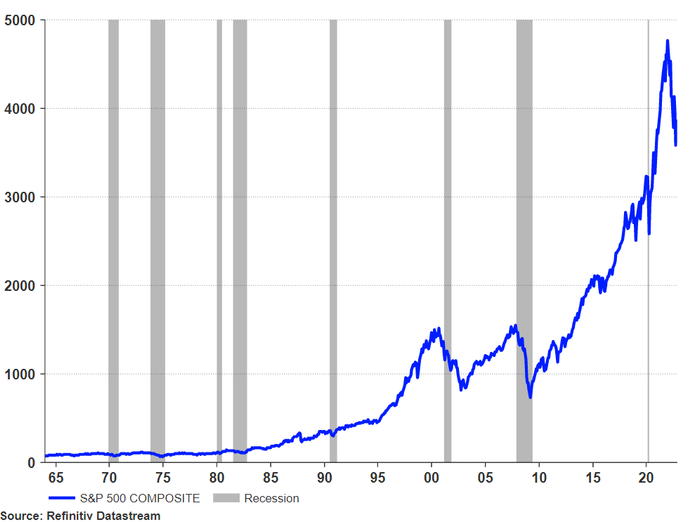Investors feeling giddy about last week’s sharp rally for stocks might want to give a listen to Tom Waits’ song, “Whistlin’ Past the Graveyard” from 1978, to sober up for the dangers that still lurk ahead.
The surge in stocks catapulted the S&P 500 index
SPX,
almost back to the 4,000 mark on Friday, also lifting it to the biggest weekly gain in roughly five months, according to Dow Jones Market Data.
Investors showed courage on signs of a slight slowing of inflation, but the fortitude also comes as a drearier backdrop for investors has been unfolding in plain sight. Massive layoffs at big technology companies, the dramatic implosion of crypto-exchange FTX, and the day-to-day pain of high inflation and skyrocketing borrowing on businesses and households are all taking a toll.
“We are not convinced this is the beginning of a new bull market,” said Sam Stovall, chief investment strategist at CRFA Research. “We believe that we are headed for recession. That has not been factored into earnings estimates and, therefore, share prices.”
Stovall also said the stock market has yet to see the “traditional shakeout of confidence capitulation that we typically see that marks the end of the bear markets.”
From Meta Platforms Inc.
META,
to Lyft Inc.
LYFT,
to Netflix Inc.
NFLX,
there is a wave of major technology companies resorting to layoffs this fall, a threat that could sweep other sectors of the economy if a recession materializes.
Yet, information technology stocks in the S&P 500 jumped 10% for the week, while financials, which stand to benefit from higher interest rates, rose 5.7%, according to FactSet.
That could reflect optimism about the odds of a slower pace of Federal Reserve rate hikes in the months ahead, after sharp rate rises helped to undermine valuations and pull tech stocks dramatically lower in the past year. However, Loretta Mester, president of the Cleveland Fed, and other Fed officials since the October inflation reading on Thursday have reiterated the need to keep rates high, until 7.7% annual rate finds a clearer path to the central bank’s 2% target.
The stock-market rally also might suggest that investors view continued mayhem in the crypto sector as contained, despite bitcoin
BTCUSD,
trading near its lowest level in two years and the shocking collapse in recent days of FTX, once the world’s third-largest cryptocurrency exchange.
Read: FTX’s fall: ‘This is the worst’ moment for crypto this year. Here’s what you should know.
What happens to stocks in recessions
Blows to the American economy rarely have been good for stocks. A look at seven past recessions, starting in 1969, shows declines for the S&P 500 as more typical than gains, with its most violent drop occurring in the 2007-2009 recession.

The more than 37% drop of the S&P 500 from 2007 to 2009 was the worst of its kind in a recession since the late 1960s.
Refinitiv data, London Stock Exchange Group
While a looming U.S. recession isn’t a foregone conclusion, CEOs of America’s biggest banks have been warning about the risks for months. JP Morgan Chase’s Jamie Dimon said in October that a “tough recession” could drag the S&P 500 down another 20%, even though he also said consumers were doing fine, for now.
Still, the steady stream of warnings about the recession odds have left many Americans confused and wondering if one can even happen without an increase in job losses.
Big moves lately in stocks also have been hard to decode, given the economy was shocked back to life in the pandemic by trillions of dollars in fiscal stimulus and easy-money policies from the Fed that are now being reversed.
“What I think goes unnoticed, certainly by the average person, is that these moves are not normal,” said Thomas Martin, senior portfolio manager at Globalt Investments, about stock swings this week.
“It’s all about who is positioned how — and for what — and how much leverage they’re employing,” Martin told MarketWatch. “You get these outsized moves when people are offside.”
Here’s a view of the sharp trajectory upward of the S&P 500 since 2010, but also its dramatic drop this year.

Sharp rise of S&P 500 since 2010, but recent fall
Refinitiv Datastream
While Martin isn’t ruling out the potential for a seasonal “Santa Claus” rally heading into year-end, he worries about a potential leg lower for stocks next year, particularly with the Fed likely to keep interest rates high.
“Certainly what’s being priced in now is either no recession or a very, very mild recession,” he said .
However, Kristina Hooper, Invesco’s chief global market strategist, said the overarching story might be one of stocks sniffing out the first steps in a path to economic recovery, and the Fed potentially stopping its rate hikes at a lower “terminal” rate than expected.
The Fed increased its benchmark interest rate to a 3.75% to 4% range in November, the highest in 15 years, but also has signaled it could top out near 4.5% to 4.75%.
“If often happens that you can see stocks do well, in a less-than-good economic environment,” she said.
The S&P 500 rose 4.2% for the week, while the Dow Jones Industrial Average
DJIA,
gained 5.9%, posting its best weekly gain since late June, according to Dow Jones Market Data. The Nasdaq Composite Index shot up 8.1% for the week, its best weekly stretch in seven months.
In U.S. economic data, investors will get an update on household debt on Tuesday, retail sales and homebuilder data on Wednesday, followed by jobless claims and housing starts data Thursday. Friday brings existing home sales.



